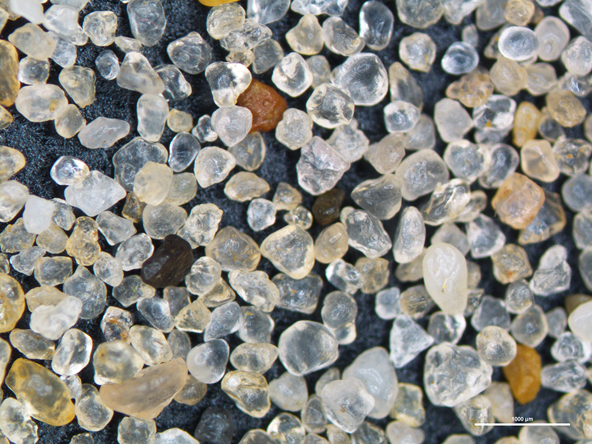
Sand. It circles the continents and stretches across deserts. There’s so much, you’d think we’d never run out. But in many places, we are.
The term “sand” just refers to the size of the grain. It can be made of many materials, but the sand we value most is made of quartz.
We use it to make glass, computer chips, roof shingles, paints, sealants, cosmetics, and much more.
But we use it most in concrete, which is about two-thirds sand. There are hundreds of tons in the average American house—and billions of tons in cities. And therein lies the rub.
Because sand is so heavy, it’s expensive to transport, meaning most sand used in buildings is local.
And the rapid growth of new cities, particularly in China, India, and other developing countries, has used up much of the high-quality local supply.
Beach sand is not a good choice for concrete—the salt can corrode the reinforcing steel. Yet some coastal cities and island nations have stripped their beaches bare for the building trade, leaving only rock.
Other communities, like Dubai and Phoenix, use their local desert sand, which is often poor quality, as well. It’s high in clay, chalk, and iron oxide.
Shortage of good-quality sand has led China to begin importing it. Elsewhere, like in India, a black market has sprung up, complete with sand mafias!
In the future, we’re likely to see a growing global trade in this surprisingly precious commodity.
Background
Synopsis: We take sand for granted. We see it on beaches and in rivers and streams, and we think it is plentiful. But as our population grows, we are consuming sand for construction, industrial, and recreational use at ever-increasing rates—and some places are running out of it.
- The term “sand” really refers to the size of the rock material, between 0.0625 and 2 mm.
- Composition of sand deposits varies greatly. Sand grains can be angular or rounded, spherical or irregularly shaped, easily crushed or very sturdy and resistant to crushing.
- Composition of sand deposits varies greatly. Sand grains can be angular or rounded, spherical or irregularly shaped, easily crushed or very sturdy and resistant to crushing.
- Sand can be composed of lots of different minerals, but the sand we value most is made of silica, which is composed of the two most abundant elements in Earth’s crust, silicon and oxygen (SiO2).
- The most common form of silica is quartz; one of the most common minerals on Earth’s surface, it is abundant in all rock types.
- On Earth’s surface, all rocks are weathered mechanically and chemically; many other minerals are broken down more easily than quartz.
- Quartz is very durable. Its strong chemical bonds make it very stable, and its lack of cleavage planes means it does not fracture easily.
- Quartz tends to travel farther than other minerals in streams and rivers on its way to the sea, where it is concentrated further by the washing of tides and waves. If the deposit is buried and lithified, sandstone forms.
- The voyage of sand grains into unconsolidated sand deposits or sandstones takes thousands to millions of years.
- Industrial sand is vital to the production of thousands of products we use in our modern economies every day.
- Sand may be mined underground or from surface pits, or it may be dredged from bodies of water. It is processed to reduce impurities and then dried, sized, and evaluated for specific applications.
- For manufacturing and industrial use, high-purity silica sand (having 95% or more SiO2) is required.
- Highest-quality silicon is required for computer chips and microprocessors.
- Silica is also essential for flooring, stucco, shingles, sealants, and caulks.
- Industrial sand is used for glassmaking, including fiberglass; metal casting and production, from engine blocks to sink faucets; chemical production, including cosmetics, paint, and coatings; and water filtration and production.
- Houses, skyscrapers, bridges, and highways are made with concrete, which is about two-thirds sand mixed with cement, gravel, and water.
- A medium-sized house can contain 200 tons of sand.
- Once sand is transformed into concrete, it is not available for other uses.
- The global population is growing and developing, and humans are extracting sand from mines, rivers, deltas, and coastal systems at record rates.
- In parts of the world, sand doesn't even make it to the oceans anymore. And beaches, which protect the coast from erosion and storms, are being depleted into vulnerable rocky shorelines.
- The demand for the right kind of sand around the world has created sand shortages and criminal “sand mafias” that illegally mine and sell sand—even resorting to violence to protect their criminal enterprise.
- In China and India, where rapid construction of infrastructure is occurring, the supply of sand that goes into road and building construction has been vastly outstripped by demand.
- Natural sand deposits in these regions that may have taken millions of years to accumulate have been exploited, and many countries now have to import sand to make up the deficit.

